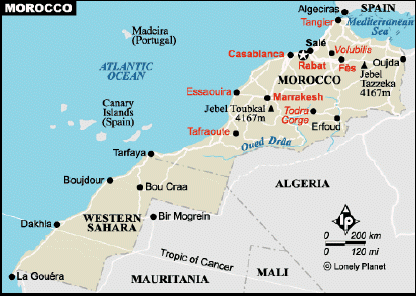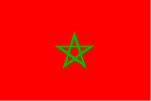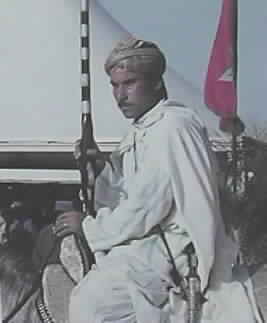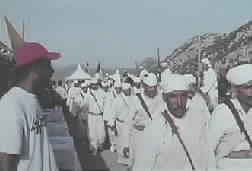|
|
|
|
|
|
|
|
|
|
|
|
|
|
|
|
|
|
|
|
|
|
|
|
|
|
|
|
 |
 |
|
 |
 |
 |
 |
 |
 |
 |
|
 |
 |
 |
 |
 |
 |
 |
 |
 |
 |
 |
 |
|
|
|
 |
 |
 |
| Map courtesy of Lonely Planet Guides |
 |
|
 |
 |
 |
 |
|
|
|
 |
 |
 |
| Vital Stats |
| National name: al-Mamlaka al-Maghrebia |
|
| Government: Constitutional monarchy |
| King: King Mohammed VI |
| Ruler: King Muhammad VI (1999) |
|
| Prime Minister: Driss Jettou |
|
| Area: 710,850 sq mi (including Western Sahara) |
|
| Population: (2001est): 30,645,305 (ave. annual rate natural increase: 1.8%); birth rate: 24.2/1000; infant mortality rate: 48.1/1000; density/sq mile: 178 |
|
| People: 55% Arab, 44% Berber, 0.7% foreigners |
| Languages: Arabic (officially) with Berber dialects, as well as French, Spanish and English |
|
| Capital (1993 est): Rabat; 1,220,000 |
|
| Largest Cities: Casablanca, 2,943,000; Marrakech, 602,000; Fes, 564,000; Sale, 521,000 |
|
| Religion: 98% Muslim, 1% Christian, 1% Jew |
| Monetary unit: Dirham |
|
| Exchange rate: (2000) 1US=10Dh |
|
| GDP: US$107 billion |
| GDP per head: US$3,200 |
| Major industries: Agriculture, manufacturing, fishing, tourism |
| Major trading partners: EU, US, Japan, Saudi Arabia, Brazil |
 |
|
|
 |
 |
 |
 |
 |
|
|
|
 |
 |
 |
| Special Note: The above picture shows Morocco proper along with the Western Sahara. The Western Sahara (the lower portion) was annexed by Morocco in 1975 and has been contested by indeginous tribes. The UN has pushed back a referendum numerous times and maintains control of the area. |
 |
|
|
 |
 |
 |
 |
 |
 |
 |
 |
 |
 |
 |
 |
 |
 |
 |
 |
|
|
 |
 |
 |
 |
 |
 |
 |
|
|
 |
 |
 |
 |
 |
 |
 |
 |
 |
 |
|
|
|
 |
 |
 |
| Keep going for more pictures and great information... |
 |
|
|
|
 |
 |
 |
 |
 |
 |
|
 |
 |
 |
 |
|
|
|
 |
 |
 |
| Although Morocco is just a couple of hours away from Spain by ferry, culturally, this Islamic nation is very different from Europe in spite of 44 years of French and Spanish colonial rule. Morocco is considered an Arab country; however, much of the population of Morocco are actually Berbers. Morocco obtained its independence from France and Spain in 1956, but many Moroccans still speak French after Moroccan Arabic or one of the three local Berber languages. |
| |
| Morocco is ruled by a constitutional monarchy where ultimate authority rests with the king, who can trace his lineage back to the Prophet Mohammed. In July of 1999, Mohammed VI succeeded to the throne on the death of his father, Hassan II. While continuing his fathers skillful management of foreign affairs, Mohammed VI has expressed intentions to increase the introduction of modernity in Morocco and to provide further benefits and opportunities to the populace. Morocco has long enjoyed close relations with the United States. Indeed, it was the first nation to recognize the United States of America in 1776, and American visitors continue to receive a warm welcome here. |
|
| A country about the size of the state of California, Morocco is located on the tip of North Africa bordering Algeria to the east, Mauritania to the south, the Atlantic Ocean to the west, and the Mediterranean to the north. The country has a mixed terrain crossed by several mountain ranges. The Atlas Mountains run across the middle of the country t the Atlantic coast. The Middles Atlas Mountains rise from the south. The Rif Mountains run along the north cost. |
|
| From the travelers point of view, this fascinating country is very accessibleonly 61/2 hours from New York to Casablanca. It has a comfortable and reliable rail and bus network, excellent roads and a state airline; more than 550 hotels, a large number of which meet the expectations of American tourists; and a populace welcoming to tourists and tolerant of differences. |
| The aphorisms and traditional phrases of Islam that punctuate the speech of many Moroccans and appear in the designs of their architecture serve to introduce to visitors the wisdom and tolerance of the legendary hospitality of the Moroccan people. The variety of experiences open to visitors is extensive, found everywhere from the medinas of historic cities, to the mysterious Sahara, to the fabulous beaches and little-traveled forests and mountains. Visitors can choose to rough it on the back of a camel in the desert, to trek across spectacular mountains, or to luxuriate in the manicured gardens and spas of exceptional hotels. |
|
| Courtesy: http://www.marrakeshvoyage.com/History.html |
 |
|
|
 |
 |
 |
 |
 |
 |
 |
 |
 |
 |
 |
 |
 |
 |
 |
 |
 |
 |
 |
 |
 |
 |
 |
 |
 |
 |
|






